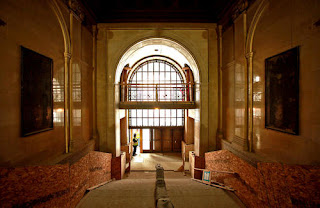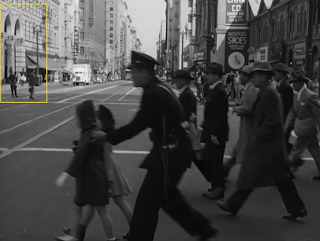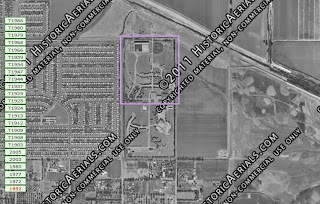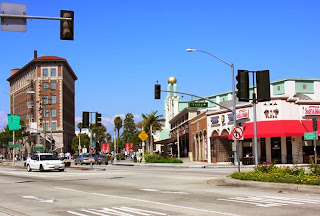Dennis Morgan and Ginger Rogers
When I watch classic movies I often watch them differently than contemporary films. With classic films I can get sucked in just by the vintage fashions and sometimes the real world film locations. That's the case with
Perfect Strangers (1950), a court room drama starring Dennis Morgan and Ginger Rogers.
The film is a day in the life of Los Angeles jurors forced to live together during a trial. Morgan plays a married man who falls in love with another juror, a woman separated from her husband, played by Rogers. The story is interesting for its look into the juror process circa 1950, but the drama is a bit lackluster. What really won me over was the fantastic Los Angeles film locations and also that the film features some of my favorite actors. In addition to Morgan and Rogers, the film also features, Thelma Ritter, Paul Ford, Alan Reed (the voice of Fred Flintstone), and other recognizable character actors.
Click on images to see larger.
United States Post Office Terminal Annex
Los Angeles Terminal Annex, 900 N. Alameda Street
The film begins with a scene of Los Angeles residents being selected at random for jury service and the notices being processed for delivery at the United States Post Office Terminal Annex located at 900 North Alameda Street, in downtown Los Angeles. In the comparison above is a screenshot of the Terminal Annex as seen in the film and an image of how the historic post office building appears today.
In the comparison below, we see a helicopter take off from the roof of the Terminal Annex. In the background, we get a glimpse of Olvera Street, the oldest part of downtown Los Angeles. One of the structures that can bee seen and is still standing is La Plaza United Methodist Church, which stands at the entrance to Olvera Street. See inside the yellow rectangle.
Terminal Annex rooftop. Olvera Street can be seen inside the yellow rectangle.
Bird's Eye View of Olvera Street as it appears today.
In the next comparison the helicopter takes off from the Terminal Annex rooftop and we see, from left to right, Los Angeles City Hall, the United States Courthouse building, and the historic Hall of Justice building.
From left to right: City Hall, Courthouse, Hall of Justice buildings.
A view of the three buildings as they appear now.
One of the people called for jury service is Ginger Rogers. In the scene below, Ginger Rogers arrives via trolley in front of Los Angeles City Hall, located at 200 north Spring Street. She gets off the trolley and walks across the street from City Hall towards the Hall of Records building.
Ginger Rogers arrives by trolley in front of City Hall.
Los Angeles City Hall, 200 N. Spring Street.
Below we see Rogers walking towards the Hall of Records building located directly across from City Hall. After Rogers arrives at the Hall of Records building she then walks next door to the Hall of Justice building. The Hall of Records was a 12-story building constructed between 1909 and 1911 and then demolished in 1973. The Hall of Justice building, which was damaged in the 1994 Northridge earthquake, has been closed ever since the quake, but is still standing and undergoing a 231 million dollar renovation.
Rogers walks towards the LA Hall of Records building.
A photo from 1954 looking down Spring Street showing the Hall of Records, Hall of Justice, and on the right, the United States Courthouse and City Hall buildings.
Looking down Spring Street in front of City Hall as it appears today.
Rogers first arrives at the Hall of Records building.
After Rogers arrives at the Hall of Records building, she then heads over to the Hall of Justice building next door. Below is a historic photo from 1947, three years before the film, showing how the Hall of Justice building appeared at the time. The building stands at the corner of Temple Street and Spring Street. The yellow circle next to the green arrow marks where Rogers can be seen walking up the sidewalk. In the second and third images, the red rectangle marks where the United States Court House building can be seen in the background.
A 1947 photo of the Hall of Justice.
The yellow circle shows Rogers in front of the Hall of Justice.
Looking down Temple Street in front of the Hall of Justice. The red rectangle marks where the United States Court House building is located (hidden behind the trees).
United States Court House building.
In the next scene, Morgan can be seen leaving a restaurant after dining with fellow juror, Rogers. The restaurant where Morgan and Rogers eat was clearly a fake created on a sound stage, but in the background of the screenshot below, we see a restaurant called the Court House Sandwich Shoppe. This was a real restaurant located on the corner of Broadway and Temple, near the Hall of Records building. Like the Hall of Records building which was demolished in 1973, the Court House Sandwich Shoppe building has also been demolished.
Morgan at the corner of Broadway and Temple. The Court House restaurant can be seen in the background.
A photo from 1954 shows the Court House Sandwich Shoppe.
The red rectangle marks the site of the Court House restaurant.
All the jurors are housed in what is supposed to be a downtown Los Angeles hotel with a view looking over City Hall and the Court House; however, I'm not 100% on this one, but I'm pretty sure that the hotel was really a facade located on the Warner Bros. Studio New York Street backlot in Burbank. Below is a screenshot of the jurors arriving at the hotel and an image of the facade I believe to be used as the location of the hotel. The signage, lamps and other details on these facades are changed all the time, but the skeleton of the building looks like it could be a match - plus, the fact that this is a Warner Bros. film, makes it likely that they could have used this facade.
The jurors arrive via bus at what is supposed to be a downtown hotel.
A Warner Bros. backlot facade I believe to be the real location.
During the trial, the jurors are taken by bus to the scene of the murder. I assumed that the bus was going down Sunset Boulevard along the Hollywood Hills, I just needed to find the right cross street, which I did when I came to Kings Road. In the scene below, the bus passes a restaurant called Leon and Freddie's, located at the corner of Sunset Boulevard and Kings Road, where the popular Saddle Ranch bar is now located.
The bus takes the jurors down Sunset Blvd at Kings Rd.
The corner of Sunset Blvd. and Kings Rd.
The "murder" took place near the cliff side of a Hollywood Hills home. This was the most interesting part of the film for me. The hills look so different today. Where at the time of the film there was mostly open land, there are now so many homes dotting the hills. After combing the hills with a few different aerial views I was finally able to pinpoint the location of the home that was used for filming. The home is located at 8412 Franklin Avenue, West Hollywood.
The bus heads up Kings Road to the scene of the crime.
Looking up Kings Road in West Hollywood.
The Hollywood Hills home sits on a cliff on Franklin Ave.
The yellow oval marks the home as seen from Kings Road.
The bus winds up Franklin Avenue in the Hollywood Hills.
The same view from Franklin Ave as it appears today.
Below the jurors get to see a reenactment of what might have been the way things played out the night of the crime. Behind them is the house that is located on Franklin Avenue up in the hills. Just below that is an image showing the home as it appears today. I was actually quite shocked when I found the home to see that it hadn't been demolished and replaced by some modern Hollywood Hills mansion. After I found the home, I did some more digging and learned that the house was built in 1944, six years prior to this film. While the jurors are at the crime scene walking around we get views of some landmark buildings as seen from the Hollywood Hills, including the Sunset Tower Hotel and the Granville Towers apartment building.
The jurors see a reenactment in front of the Franklin Ave home.
Over 65 years and the home is still standing. An eternity by LA standards.
Below, jurors take in the view from the Hollywood Hills. The art deco Sunset Tower Hotel can be seen in the background. The hotel has long been a residence for Hollywood celebrities, including John Wayne, Marilyn Monroe, Clark Gable, Errol Flynn, Paulette Goddard, Preston Sturges, Billie Burke, and Zsa Zsa Gabor.
The Sunset Tower Hotel as seen in the film.
A Bird's Eye View of the Sunset Tower Hotel.
In another scene we get a view showing the Granville Towers, a posh West Hollywood apartment building built in 1930 by legendary architect, Leland Bryant. The Granville Towers has been the home to many notable celebrities, including Marilyn Monroe, Rock Hudson, and singer David Bowie.
The Granville Towers as seen in Perfect Strangers.
A Bird's Eye View of the Granville Towers.
During the reenactment at the crime scene, we get this view looking down from Franklin Avenue in the Hollywood Hills towards the next street below, Hollywood Boulevard. Amazing enough, the homes located on Hollywood Boulevard at the time of the film still appear to be intact.
Looking down from Franklin Ave toward Hollywood Blvd.
Bird's Eye View of Franklin Ave. and Hollywood Blvd.
In one scene during the film we get a glimpse of a news ticker on the side of a building announcing an update to the trial. That news ticker was a big deal. According to a The Billboard magazine article from September 7, 1946, on a Tuesday night, August 6, 40,000 people showed up to see the premiere of that sign, the "Trans-Lux Flashcast news ribbon...brought to Los Angeles by Warner Bros. KFWB." The news ribbon was located on the side of of the historic Taft building at the intersection of Hollywood and Vine, in Hollywood.
The news ribbon as seen in Perfect Strangers.
A crowd gathers under the news ribbon at Hollywood and Vine. Photo from the Flickr page of
AliceJapan.
The Taft building in Hollywood. The news ribbon has been removed.
During the final scenes of the film we see the jurors leaving the Hall of Justice building back in downtown Los Angeles. As I mentioned before, the Hall of Justice has been closed ever since the 1994 Northridge earthquake, this is a great glimpse inside of the historic building. Below is a screenshot from the film showing Dennis Morgan exiting the Hall of Justice and a contemporary image showing how the same location appears today.
Dennis Morgan leaves the Hall of Justice.
A contemporary view of the Hall of Justice.
The interior of the Hall of Justice appears in another film I've blogged about, the 1978 film
The Big Fix, starring Richard Dreyfuss.
















































































